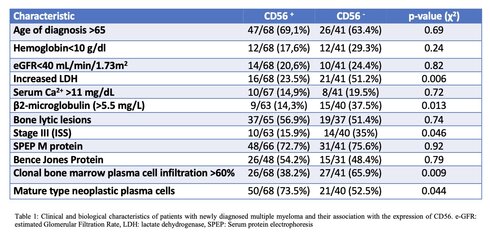
Contributions
Abstract: EP955
Type: E-Poster Presentation
Session title: Myeloma and other monoclonal gammopathies - Biology & Translational Research
Background
CD56 or neural cell adhesion molecule (NCAM) is a membrane glycoprotein expressed on neural cells, muscle tissues and myeloma cells. Expression of CD56 has been studied in patients with multiple myeloma (MM), however with controversial results.
Aims
The scope of this study was to examine the expression of CD56 and investigate its association with clinicopathologic parameters.
Methods
We retrospectively collected and analyzed data from 109 patients with MM diagnosed over the last decade (January 2010 to June 2020). We assessed the expression of CD56 in bone marrow biopsies with immunohistochemistry and investigated its association with a variety of clinicopathological parameters. For the statistical analysis χ2 test and Mann-Whitney U test were used to compare categorical and continues valuables in CD56+ and CD56- patients, respectively. Statistical analysis was performed using SPSS 21.0 for Windows (SPSS, Chicago, IL).
Results
We assessed 109 patients with MM; Based on the expression of CD56 the patient population was divided to CD56+patients and CD56- patients; Sixty-eight patients were CD56+ and 41 patients were CD56-. The median age at diagnosis of MM was 70 years in CD56+ patients and 72 years in CD56- patients (p=0.7). Lack of CD56 expression was associated with unfavorable prognostic parameters such as elevated lactate dehydrogenase (LDH) and β2-microglobulin levels, advanced stage in International Staging System (ISS) and clonal bone marrow plasma cell percentage ≥ 60%, while the expression of CD56 was associated with good differentiation of neoplastic plasma cells. The clinical and biological parameters of the patients at the time of diagnosis of MM are presented in Table 1.

Conclusion
Our study confirmed that CD56 is a possible marker of poor prognosis in patients with MM. The measurement of expression of CD56 via either immunohistochemistry or flow cytometry is simple and cheap, and it could be incorporated in future prognostic or predictive scores. Prospective studies are needed in order to evaluate the role of expression of CD56 as a predictive biomarker in the era of novel regimens.
Keyword(s): CD56, Multiple myeloma, Prognostic factor
Abstract: EP955
Type: E-Poster Presentation
Session title: Myeloma and other monoclonal gammopathies - Biology & Translational Research
Background
CD56 or neural cell adhesion molecule (NCAM) is a membrane glycoprotein expressed on neural cells, muscle tissues and myeloma cells. Expression of CD56 has been studied in patients with multiple myeloma (MM), however with controversial results.
Aims
The scope of this study was to examine the expression of CD56 and investigate its association with clinicopathologic parameters.
Methods
We retrospectively collected and analyzed data from 109 patients with MM diagnosed over the last decade (January 2010 to June 2020). We assessed the expression of CD56 in bone marrow biopsies with immunohistochemistry and investigated its association with a variety of clinicopathological parameters. For the statistical analysis χ2 test and Mann-Whitney U test were used to compare categorical and continues valuables in CD56+ and CD56- patients, respectively. Statistical analysis was performed using SPSS 21.0 for Windows (SPSS, Chicago, IL).
Results
We assessed 109 patients with MM; Based on the expression of CD56 the patient population was divided to CD56+patients and CD56- patients; Sixty-eight patients were CD56+ and 41 patients were CD56-. The median age at diagnosis of MM was 70 years in CD56+ patients and 72 years in CD56- patients (p=0.7). Lack of CD56 expression was associated with unfavorable prognostic parameters such as elevated lactate dehydrogenase (LDH) and β2-microglobulin levels, advanced stage in International Staging System (ISS) and clonal bone marrow plasma cell percentage ≥ 60%, while the expression of CD56 was associated with good differentiation of neoplastic plasma cells. The clinical and biological parameters of the patients at the time of diagnosis of MM are presented in Table 1.

Conclusion
Our study confirmed that CD56 is a possible marker of poor prognosis in patients with MM. The measurement of expression of CD56 via either immunohistochemistry or flow cytometry is simple and cheap, and it could be incorporated in future prognostic or predictive scores. Prospective studies are needed in order to evaluate the role of expression of CD56 as a predictive biomarker in the era of novel regimens.
Keyword(s): CD56, Multiple myeloma, Prognostic factor


